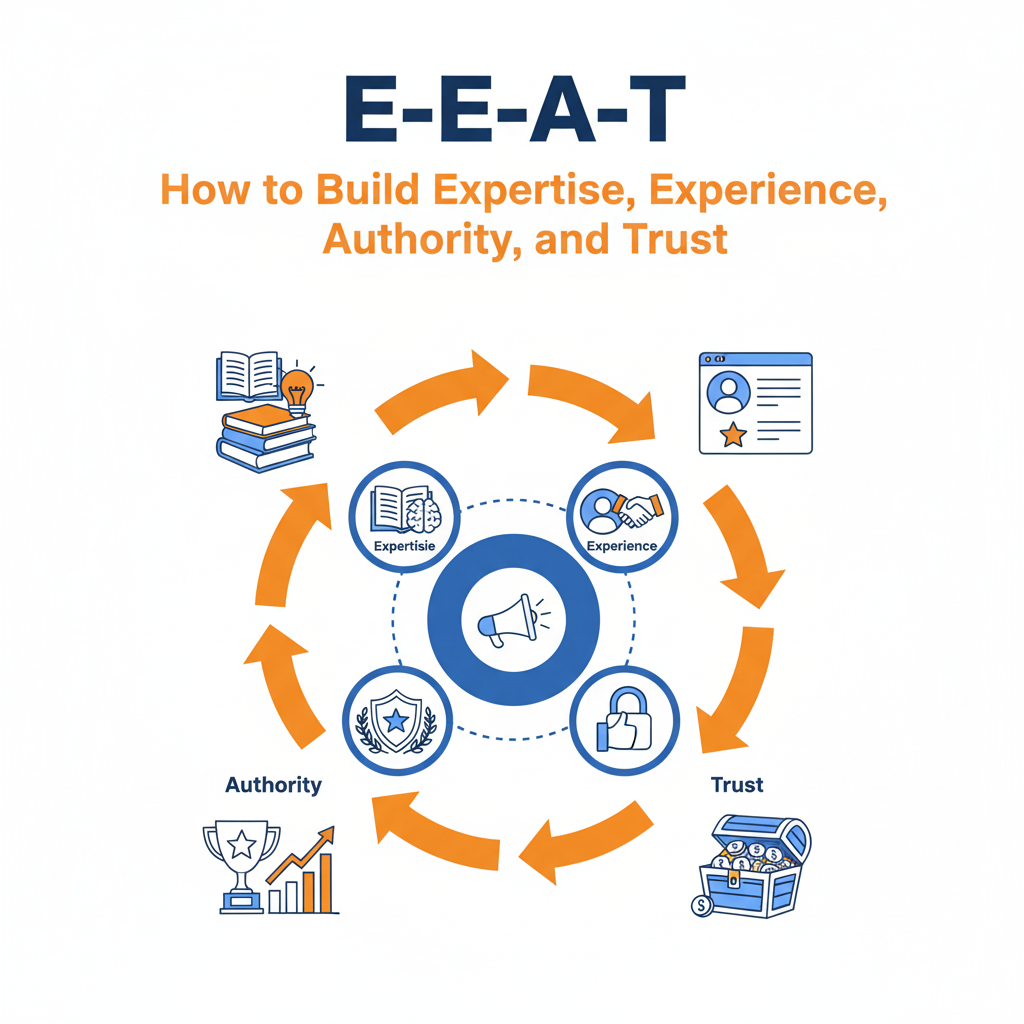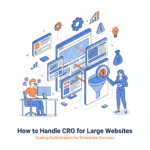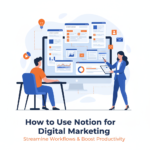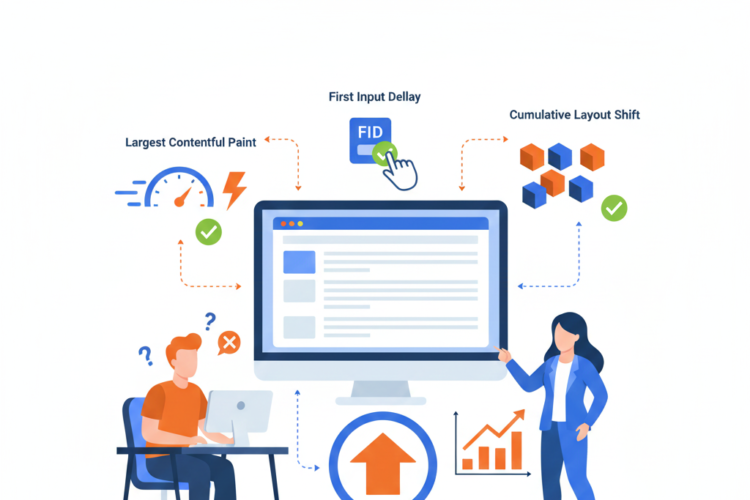
E-E-A-T: How to Build Expertise, Experience, Authority, and Trust
Introduction
Search engines are no longer just ranking pages — they’re ranking credibility.
In an era where AI-generated and low-quality content flood the internet, Google’s E-E-A-T framework (Experience, Expertise, Authority, and Trust) has become the cornerstone of SEO success. It’s how Google decides whose content deserves visibility and which websites users can rely on.
Whether you’re running a blog, an eCommerce store, or a B2B brand, understanding and implementing E-E-A-T isn’t optional — it’s essential.
In this guide, we’ll explore what E-E-A-T really means, how Google evaluates it, and the exact strategies you can use to strengthen your site’s credibility and rankings.
1. What is E-E-A-T?
E-E-A-T stands for:
E – Experience
E – Expertise
A – Authority
T – Trust
It’s a concept from Google’s Search Quality Rater Guidelines, which real human evaluators use to assess the quality of search results.
While E-E-A-T isn’t a direct “ranking factor” (like backlinks or page speed), it influences Google’s algorithms to prioritize trustworthy and authoritative content.
2. The Evolution: From E-A-T to E-E-A-T
Originally, Google introduced E-A-T (Expertise, Authority, Trust) in 2018.
In December 2022, Google added a new “E” — Experience.
Why?
Because firsthand experience adds authenticity and credibility, especially in niches like health, finance, product reviews, and travel.
Example:
A financial advisor writing about “how to invest in index funds” shows expertise.
An investor sharing personal results and screenshots of portfolio growth demonstrates experience.
Google now wants both — professional knowledge and real-world insight.
3. Why E-E-A-T Matters
E-E-A-T influences how Google perceives:
Who you are (brand reputation)
What you say (content quality)
How you say it (accuracy and authenticity)
If your website lacks E-E-A-T, you risk lower rankings, especially for YMYL (Your Money or Your Life) topics — content that impacts readers’ health, finances, or safety.
E-E-A-T Is Critical For:
Healthcare & wellness blogs
Finance & investing websites
Legal services
Product reviews & affiliate sites
News publishers
Educational content platforms
Strong E-E-A-T helps your site:
✅ Rank higher in SERPs
✅ Build audience trust
✅ Increase conversion rates
✅ Earn quality backlinks
4. The Four Pillars of E-E-A-T
Let’s break each element down.
A. Experience
Experience reflects the real-world involvement or hands-on knowledge of the author or brand.
Google favors content created by individuals who have personally used, tested, or experienced the subject matter.
Example:
A traveler describing “Top 10 Cafes in Paris” with original photos and reviews shows experience.
A product review that includes “I bought this item and here’s my 3-month update” demonstrates firsthand credibility.
How to Demonstrate Experience
Add personal stories, examples, or case studies.
Include images or videos from your own experiences.
Publish customer testimonials or user-generated content.
Encourage reviews and feedback loops.
B. Expertise
Expertise means deep knowledge or qualification in a topic.
Google looks for signals that show the author (and site) has the right background to discuss the subject.
Example:
A nutritionist writing about diet plans = high expertise.
A random blogger writing about medical conditions = low expertise.
How to Build Expertise
Display author bios with credentials and achievements.
Get certifications or verifiable qualifications in your niche.
Publish in-depth, well-researched articles.
Reference authoritative studies and data sources.
Keep content updated with the latest facts.
C. Authority
Authority reflects recognition from others — how respected you or your website are in your industry.
It’s built over time through mentions, citations, backlinks, and media coverage.
Example:
If other industry leaders quote your content or link to it, Google sees you as an authority.
How to Build Authority
Earn backlinks from credible, niche-relevant sites.
Contribute guest posts to reputable publications.
Collaborate with influencers and experts.
Participate in webinars, podcasts, and industry events.
Encourage mentions and citations of your brand or research.
D. Trust
Trust is the most important pillar — it’s the foundation that ties everything together.
Without trust, even expertise and authority lose value.
Google looks at trust signals such as:
Website security (HTTPS)
Transparent contact and “About” pages
Honest product or affiliate disclosures
Accurate information
Positive reviews and reputation management
How to Build Trust
Use HTTPS and secure hosting.
Display physical address, phone number, and team info.
Respond to reviews and feedback transparently.
Cite credible data sources.
Avoid clickbait, exaggerated claims, or misleading titles.
Keep your privacy policy and terms of service visible.
5. How Google Evaluates E-E-A-T
Google doesn’t assign a numeric E-E-A-T “score.” Instead, its algorithms and human evaluators assess overall credibility through:
| Signal Type | Examples |
|---|---|
| On-Page Signals | Author bio, sources cited, accurate facts |
| Off-Page Signals | Backlinks, mentions, social proof |
| Technical Signals | HTTPS, schema markup, UX quality |
| Reputation Signals | Reviews, brand mentions, sentiment |
Quality Raters use E-E-A-T guidelines to train Google’s AI systems, helping them understand what “trustworthy” content looks like.
6. Practical E-E-A-T Optimization Strategies
Here’s how to build E-E-A-T systematically:
1. Strengthen Author Pages
Include full bios with credentials, expertise, and social links.
Add profile photos and personal stories to humanize content.
Link author pages to their LinkedIn or professional profiles.
2. Improve Site Transparency
Include clear “About Us” and “Contact” pages.
Add company mission, team members, and certifications.
Display editorial policies if publishing informational content.
3. Optimize Content Quality
Reference data-driven studies and sources.
Avoid generic, keyword-stuffed writing.
Provide actionable insights with unique perspectives.
Include visuals, charts, or infographics for better comprehension.
4. Earn Backlinks Naturally
Create linkable assets: research reports, surveys, guides.
Pitch your content to journalists via platforms like HARO.
Collaborate with thought leaders or institutions for co-authored pieces.
5. Manage Online Reputation
Monitor brand mentions with tools like Google Alerts.
Encourage happy customers to leave reviews.
Address negative reviews promptly and professionally.
6. Implement Structured Data (Schema)
Use Person, Organization, and Review schema to help Google understand authorship, credibility, and trustworthiness.
7. Maintain Consistency
Ensure consistency across:
Social profiles
NAP (Name, Address, Phone) details
Business listings and directories
Consistency reinforces authenticity and trust.
7. Common Mistakes That Weaken E-E-A-T
| ❌ Mistake | 💡 Why It Hurts |
|---|---|
| Publishing unverified or inaccurate content | Damages trust and reputation |
| Using anonymous or fake author profiles | Reduces perceived expertise |
| Ignoring fact-checking or citations | Signals low editorial quality |
| Poor site design or security | Decreases user confidence |
| Overpromising in headlines | Increases bounce rate and distrust |
8. Measuring Your E-E-A-T Progress
While you can’t directly “measure” E-E-A-T, you can track related metrics:
| Metric | What It Indicates |
|---|---|
| Backlink quality | External validation (authority) |
| Referral mentions | Industry recognition |
| User engagement (time on page, bounce rate) | Content quality and trust |
| Branded search volume | Brand credibility growth |
| Review ratings | Trust and customer experience |
Use tools like Ahrefs, Google Search Console, and Brand24 to monitor these signals over time.
9. Examples of Strong E-E-A-T Websites
| Industry | Example | Why It Works |
|---|---|---|
| Health | Mayo Clinic | Verified medical authors, accurate sources, trust signals |
| Finance | NerdWallet | Clear author credentials, transparent disclosures |
| Tech | HubSpot | Deep expertise, research-based guides |
| Travel | Lonely Planet | Firsthand traveler experiences, expert recommendations |
These brands blend experience, expertise, authority, and trust seamlessly — creating a strong SEO and user perception advantage.
10. The Future of E-E-A-T
As Google moves toward AI-driven search (Search Generative Experience – SGE), E-E-A-T becomes even more critical.
Why? Because AI summaries and search snippets will highlight verified, credible sources first.
Future ranking models will rely on brand trust signals, not just keyword relevance.
In short:
“In the age of AI, authenticity is your best SEO strategy.”
Conclusion
E-E-A-T isn’t just a guideline — it’s the foundation of digital credibility.
It helps you prove that your content deserves visibility, trust, and authority in your industry.
By showcasing real experience, verified expertise, earned authority, and unquestionable trust, you’ll not only win Google’s favor but also earn your audience’s loyalty.
Author



